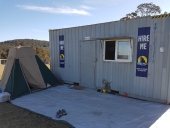I am currently living in a 8'x9.5' older pickup truck camper parked in one bay of an un-heated pole-barn shop structure while I am building my own tiny house inside another bay of the same pole-barn shop structure which will be a significant upgrade for me compared to the camper.
Things I can suggest from my experience so far:
1. - Do not use a direct vent cadalitic propane heater in a small space unless you want serious moisture condensation problems. The camper came equipped with such a heater and I had to stop using it and go to using an electric space heater because of moisture problems. Opening a window a crack (required for fresh air anyway when using such a heater), opening big window all the way, electric fan forced fresh air circulation, etc. . . None of that is sufficient to prevent moisture problems with extended use and the last two options you loose most of your heat as well. Cooking with propane is not a problem and a propane heater that vents outside would probably be fine as well. Just DO NOT think you can use one of those direct went cadalitic heaters for a long term heat source. Yes they are really efficient and probably cheaper for the camper manufacturer to install but they are not suitable for a long term small space heating solution.
2. - Insulation is important and the foam board stuff is awesome! The camper I'm living in while I build has only 1-1/2" thick walls but they are filled with just basic white foam board not even the better quality foam board and even with that thin and lower quality foam and thermal losses through the windows and thermal bridging through the 2x2 studs in its walls it still stays toasty warm with just a 1,500 watt electric space heater all the way down to sub-zero Winter weather. Some of that is helped by being parked inside the pole-barn shop structure but that really only serves as a wind-break/buffer since the structure is un-heated, un-insulated, and not even completely weather tight. The tiny house for comparison is going to have over double the thickness of foam board board insulation on the walls and more then four times the thickness of foam board insulation on the roof and with very few thermal bridging possibilities. Thus I'm expecting my tiny house to stay just as toasty warm with the same or even less heating input even though it's going to be significantly larger then the camper.
3. - Floors are the hardest thing to heat and cold floors are a real pain! I would strongly suggest considering some form of in floor heating especially for a tiny house on wheels. Even though it's floor is insulated with foam board the same as the walls and ceiling in the camper I'm living in while I build no matter how hot I get it inside the camper in the winter the floor is still cold because heat rises and being up above the ground on jack stands with a pocket of cold outside air underneath it the floor never warms up. Which with a tiny hose built on a trailer would be the same situation and no skirting doesn't help all that much. Probably the cheapest and simplest way to do heated floors in a tiny house would be with the those cut to fit electric heating mats, for me though in my build since it's not on a trailer but I am putting in a deep insulated perimeter natural stonework foundation with stonework floor I am using a combination of passive geothermal and water circulation tubes installed in the floor an hooked up to both a water jacket on the wood stove and a gas hot water heater. But if I were building the usual tiny house on a trailer I would install electric heating mat in the floor for sure.
4. - Furniture that folds up/down or otherwise transforms to fill multiple rolls will only actually be used as such if the conversion is VERY EASY to do! If you are going to have a murphy bed or bed/table conversion it will stay as a bed unless it is very easy to convert when you get up in the morning. To this end I have designed the murphy bed unit for my tiny house such that it folds up via electric winch (just hold the winch button down to fold up bed) and you have to fold the bed up to easily get to the clothes storage drawers built into the wall. Thus the bed will actually get folded up!
5. - You don't actually need very much electricity if you are smart how you use it. So far I have had no problems living off of a single 20amp 120V service including electric heat. Granted my hot water heater and stove/oven are propane. But I am running a small fridge, medium chest freezer, microwave, TV, computer, lights, airconditioning, and the electric space heater all of just that single circuit. All the appliances are energy efficient models and I use LED light bulbs and when I want to use the microwave I turn off the electric heater or air conditioner for a moment while using the microwave and then turn back on when done using the microwave. If you are already using propane for cooking and hot water and especially if you heat with it as well unless you have a specific energy hogging electric appliances you must run together at the same time you really don't need anything more then 20amp 120v service for a tiny house. Which if you limit yourself to that gives you a lot of options sine all you need is a heavy duty contractor grade extension cord and a full 20amp rated exterior plug in to plug into. Without electric heat you could probably even get away with just a 15amp standard exterior outlet service.









